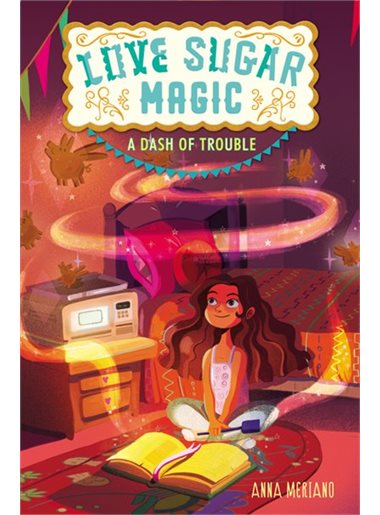Love Sugar Magic: A Dash of Trouble by Anna Meriano, 2018
Children’s novel for grades 4-8; fantasy
 Eleven-year-old Leo (short for Leonora) is upset that she isn’t allowed to take the day off from school to help out in her family’s bakery. Tomorrow is the Dia de los Muertos festival in her small Texas town, and there’s so much work to do that Leo’s four older sisters are all spending the day in the bakery. Leo is tired of being told she’s too young. In an act of defiance, she sneaks to the bakery and hides to spy on her mother, aunt, and sisters. That’s when she discovers that her family has a big secret. (And it’s yet another thing that she’s left out of because she’s too young) All the women in her family are brujas, Spanish for “witches” or “magicians.” Leo is desperate to learn more. While snooping, she finds a spellbook that answers some of her questions, and she manages to coax some information out of her sisters as well. When Leo begins trying her own hand at magic, things predictably go wrong due to her lack of magical experience and knowledge.
Eleven-year-old Leo (short for Leonora) is upset that she isn’t allowed to take the day off from school to help out in her family’s bakery. Tomorrow is the Dia de los Muertos festival in her small Texas town, and there’s so much work to do that Leo’s four older sisters are all spending the day in the bakery. Leo is tired of being told she’s too young. In an act of defiance, she sneaks to the bakery and hides to spy on her mother, aunt, and sisters. That’s when she discovers that her family has a big secret. (And it’s yet another thing that she’s left out of because she’s too young) All the women in her family are brujas, Spanish for “witches” or “magicians.” Leo is desperate to learn more. While snooping, she finds a spellbook that answers some of her questions, and she manages to coax some information out of her sisters as well. When Leo begins trying her own hand at magic, things predictably go wrong due to her lack of magical experience and knowledge.
I’m looking forward to seeing how this series continues. I feel like there’s a lot of fun stuff that Meriano can do with this premise, and the characters are likable and distinctive enough to keep readers interested in following their ongoing story. The mostly-positive family relationships and usually-good intentions of the characters sets a light-hearted, feel-good tone. (There’s some bickering, selfishness, and poor choices, but just enough to be believable) Although most of the major plot points are results of wrong things that Leo does, her thought process is presented in a way that almost makes her decisions seem natural. And her narrative voice (although the text is in third person) is very authentic. It realistically captures the thoughts and feelings of an eleven-year-old girl who feels left out and is desperate to achieve things and prove her capabilities. Despite the fantasy elements, this story also has strong appeal factors for middle-grade readers who generally prefer realistic fiction.
Another thing that makes this book noteworthy, at least to me, is the Hispanic characters and cultural backdrop. My library is in a community with a large Hispanic population, so that’s definitely a demographic niche that I want to be well-represented in our collection. But most middle-grade books featuring Hispanic characters are serious realistic fiction, and many are specifically about social issues. It’s great to have those books, but some kids would rather read a fun book about magical cookies. And I think that a lot of my library kids share Leo’s conviction that Dia de los Muertos is the best holiday, so it’s great that this book involves that celebration without portraying it as something foreign and exotic. Leo doesn’t speak Spanish fluently, but most of her family members do, and there are a lot of Spanish words and phrases in this book. I don’t just mean that the characters use a few well-known Spanish words like “hola” and “gracias”; there are entire recipes that Leo reads in Spanish and must translate in order to understand.
But maybe the best thing of all about this story is that it’s about baking. Cookies and breads are a constant motif, and the book has a good number of recipes at the end of the book. (The ones interspersed throughout the text call for magical ingredients like spiderwebs, signatures, and people’s eyelashes, in addition to actually edible things) Magic is repeatedly described as having a distinctive spice-like smell. All of the sugar and spice in the story add up to make the overall effect, well, sweet. I’d recommend this book to most middle-grade readers and to adults with a vested interest in middle-grade fiction.